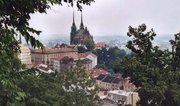Brno
|
|
| Statistics | |
|---|---|
| Area: | 230 km² |
| Population: | 369,559 (2003) |
| Map | |
| Missing image Czech_city_Brno.png Map of the Czech Republic highlighting Brno | |
Brno Template:Audio (German: Brünn) is the second-largest city of the Czech Republic, located in the southeast of the country, at the confluence of the Svitava and Svratka rivers. The town is a political and a cultural hub of the South Moravian Region (population est. 1,125,000).
| Contents |
History
Spilberk2.jpg
Brno was founded in 1243; the area had been settled since the 5th century. It was used as a stronghold until the middle of the 19th century. Then the fortifications were replaced by green areas and buildings in the Viennese style. The Spielberg fortress (Czech Špilberk), the castle of Brno, was probably the best known prison of the Austrian Empire until 1858.
Soon after the industrial revolution, the town became one of the industrial centres of Moravia. Sometimes it is called the Czech Manchester. The Brno University of Technology was established in 1899; since 1995, the university have been developing the Czech Technology Park.
Many expositions have been held at the Fairground Site of Brno since 1928; the annual International Engineering Fair of Brno and Invex are probably the most important ones.
Villa Tugendhat, designed by Mies van der Rohe and built in the late 1920s close to the centre of the city, is known as a monument of modern architecture, and was designated a World Heritage Site by UNESCO in 2002.
Masaryk University was established in 1919.
Masaryk Circuit was built in the 1980s in the northwest of the town.
The Constitutional Court of the Czech Republic, Supreme Court of the Czech Republic and Highest Prosecutor's Office of the Czech Republic moved to Brno or were established there in 1993, after the division of Czechoslovakia.
Brno Today
In the 1990s, after more than 70 years of discussions, the town hall decided to build a new main train station further from the centre of the town and to develop a modern town quarter at the place now occupied by the tracks. This plan has been often criticised for its possible economical and ecological consequences. The whole Brno railway junction is to be reconstructed, which is very complicated due to its 170 years of development since the first train came to Brno from Vienna in 1839. The construction should be finished in 2017.
Ignis Brunensis, an international fireworks competition, is held each June. The show attracts more than 200,000 spectators regularly.
A unique slang spoken in Brno is called Hantec.
Famous people associated with Brno
- Kurt Gödel - a mathematician
- Leoš Janáček - a composer
- Viktor Kaplan - an inventor
- Milan Kundera - a writer
- Ernst Mach - a physicist
- Jiří Mahen - a writer
- Gregor Mendel - the founder of genetics
- Robert Musil - a writer
- Arne Novák - a literature theorist
- Jan Skácel - a poet
External links
- Official Website of Brno (http://www.brno.cz/index.php?lan=en)
- The Moravian Museum (http://www.mzm.cz/Default-en.htm)
- Official Website of Villa Tugendhat (http://www.tugendhat-villa.cz/html.en/)
- Moravian Gallery in Brno (http://www.moravska-galerie.cz/eng/)
- The Brno House of Art (http://www.dumb.cz/index_en.html)
- The International Biennale of Graphic Design in Brno (http://www.bienale-brno.cz/2004/en/index.html)
- The Masaryk University (http://www.muni.cz/to.en/)
- The Brno University of Technology (http://www.vutbr.cz/to.en/)
- The Janacek Academy of Music and Performing Arts in Brno (http://www.jamu.cz/)
- The Mendel University of Agriculture and Forestry (http://www.mendelu.cz/)
- Capuchin Crypt (http://www.volny.cz/kapucini.brno/hrobkaa.htm)
See also
- Asteroid 2889 Brno, named after the citybg:Бърно
ca:Brno cs:Brno da:Brno de:Brünn es:Brno eo:Brno fr:Brno it:Brno nl:Brno ja:ブルノ pl:Brno sk:Brno sv:Brno

